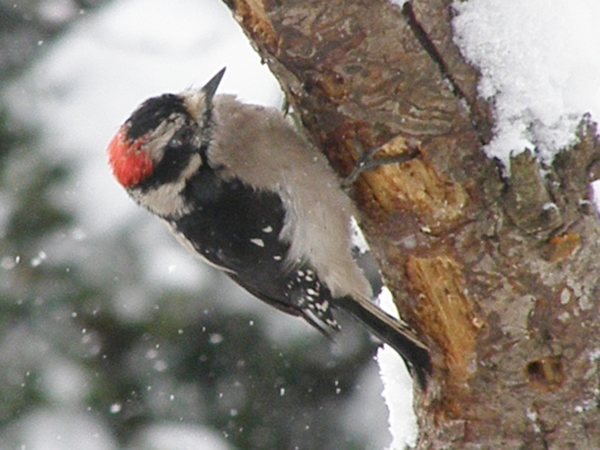In the Depth of Winter. |
||
Winter brings fresh problems to our feathered friends in their search for food and shelter. Rivalries spring up around the feeding stations which lead to lost energy and a greater need for the food that you supply. |
 |
||
Many birds in the northern areas do not migrate and have adapted to living in some extreme conditions. This Steller's jay, perched here with the snow continuing to fall is one that has adapted. These birds and many other residents will frequent the feeding stations that many birders maintain. Jays love peanuts in the shell and often take one or two to hide them away in a tree nearby or bury them in the garden. They store these extra nuts for later use, although they do forget where many of them are. Besides losing out on those lost morsels, other Jays watch where they are hidden and snatch them. Squirrels will often find them when they are able to have a break in the weather. This also happens in the wild with acorns that are hidden. When picking and storing acorns, soft damp soil provides a quick means of covering, and an ideal location for growing oak seedlings. |
||
 |
||
Probably the hardest hit in the long winter months are the hummingbirds that do not leave for the warmer areas. Although many people feed them throughout the summer, when it is their time to leave, they leave. Because you may have a couple of feeders hanging up for them, you cannot make them stay; they go when the time arrives. For the hummingbirds that do stay however, extra effort on your part is called for. Frozen feeders need to be defrosted, again, spare feeders that can replace the frozen ones makes life easier all round. |
||
 |
||
Some overhead protection from the snow is also helpful. If it is possible where your feeders are located to add a protective roof, it would be worth the effort putting one up. A simple readymade roof can be obtained from most garden centers, one of those green saucers used to stand a plant pot in is ideal. Purchase one about eight or nine inches for complete coverage. Drill ¼ inch hole in the centre of it for the hanging hook, and screw the hook it into a suitable structure. |
||
 |
||
During inclement weather the birds still search for water. Substituting snow for drinking water takes a lot of the bird’s energy. Besides requiring water for drinking, they also enjoy bathing, so keeping the dishes free of snow and ice is really important through these cold winter months. An extra bathing dish kept indoors for these occasions saves time removing the snow and thawing any ice that may be present. |
||
 |
||
A table can be used for scattering the seed for the seed eaters. It would be very helpful if it could be moved to a sheltered area during the winter months. The birds that visited your feeding station through the summer will accept a new location. Woodpeckers present us with a different problem from the seed eaters. Any hanging log feeders could be snow covered thus having the woodpeckers search for the food. Those suet block cages are very good but these too can be covered with snow. |
||
 |
||
A small roof over both will protect them and ease the work effort of the birds. It is also possible to be able to raise the roof for replacing the suet blocks. A hanging cord passing through the roof at each end, and secured to the sides of the cage can make for easy loading. |